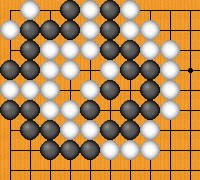santo wrote:
...
http://www.cs.cmu.edu/~wjh/go/rules/Japanese.html... the rules specifically say that all dame and teire MUST be played is to be found here in the "detailed version" of rule 9:
https://www.nihonkiin.or.jp/match/kiyaku/kiyaku09.html. There at least it seems that this word you mention, "hitsuyo", appears (必要).
Yes, that is the page I was looking at. I haven't actually read the English translation. I see you found the additional text in the English translation but you might be interested to know that at least one example in the online Japanese Rules was changed compared to the older English translation (it was Example 18, also mentioned below). This was discussed somewhere here recently. I haven't looked myself. Other things might be different as well.
Two parts of the Japanese Rules, which are not in the English translation you linked, that I found enlightening are the
Preample by the Committee and the
Summary of the Revision. I think failure to read these portions has led to some misconceptions.
santo wrote:
I can't read Japanese, so having a translation for this extra official text that I was not even aware existed would be wonderful, but I am afraid maybe no one has done so yet?
You can search here and see that we almost had a well-known and respected translator work to translate the rules as the Japanese would read them. But we are too ornery to have nice things. As for myself, I am learning Japanese and so I use computer translations and dictionaries (jisho.org and Kenskusha's Jp-En dictionary).
santo wrote:
For example, pseudosekis like the one I linked disappear: The referee fills whites one-sided dames before life and death determination, thus the position is not seki, even though white would prefer to avoid filling the dames to make seki.
I don't see any issue with Mef's pseudoseki from the other post. My understanding of the Article 9-2 explanation is that the play of dame and teire are not actually moves in the game. So it's not like one player could demand to resume from the not-the-actual-game position after dame and teire are played. The real issue in the pseudoseki seems to be that White wants Black to make a mistake. Maybe a referee would be needed if the pseudoseki White player were obstinate.
santo wrote:
I mean, the fact that strict life and death analysis as per the rules would not start *exactly* from the positions the players actually left on the board was not an option to me.
My understanding (some disagree) is that not only does life and death analysis not "start from the position the players actually left on the board," but that there is no "starting" from any position at all. I don't see any basis for so-called "hypothetical play" actually happening during Life & Death confirmation under the Japanese rules. In the Preamble and Summary the Committee states that the revisions create rules having a consistent rationale to appease Westerners and that they have dismissed inconsistent rulings (Torazu sanmoku - “three points without capturing”). The examples of play to show L&D are simply explaining how the rulings have consistency from the same rationale (re-taking a ko requires a pass). There is no suggestion that this type of play would actually take place during L&D confirmation. See Example 18 where black's upper-left group is deemed dead (Bent 4) and so there is a seki-collapse. At this point in the Examples, Bent-4 has already been defined as being dead according to Example 7-1, and a seki-collapse position has already been defired, so there is no need to "hypothetically" play it out. Furthermore, if players found a position like Example 18 during L&D Confirmation and they actually tried to "hypothetically" play it out, they might endlessly take and retake the double ko between passes without getting around to creating the bent 4. But this is not how L&D confirmation works. Note that the L&D examples have a particular play-style/goal. They are not playing to "win" (e.g., endlessly retaking a ko, or recreating a position that cannot be killed), they are playing to show whether groups of stones can be captured or not (e.g., Example 13). So anyway, I think discussion of the Japanese Rules based on "hypothetical play" is misleading.




